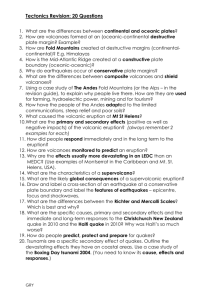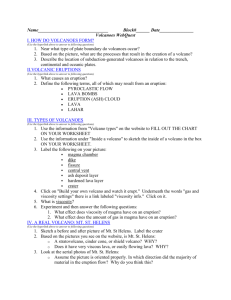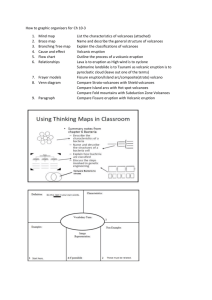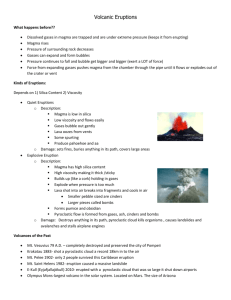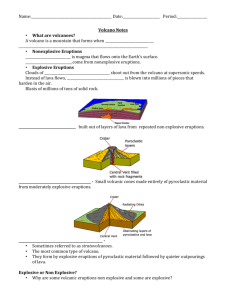Volcanoes! Investigating Volcanic Eruptions and Flow Viscosity
advertisement
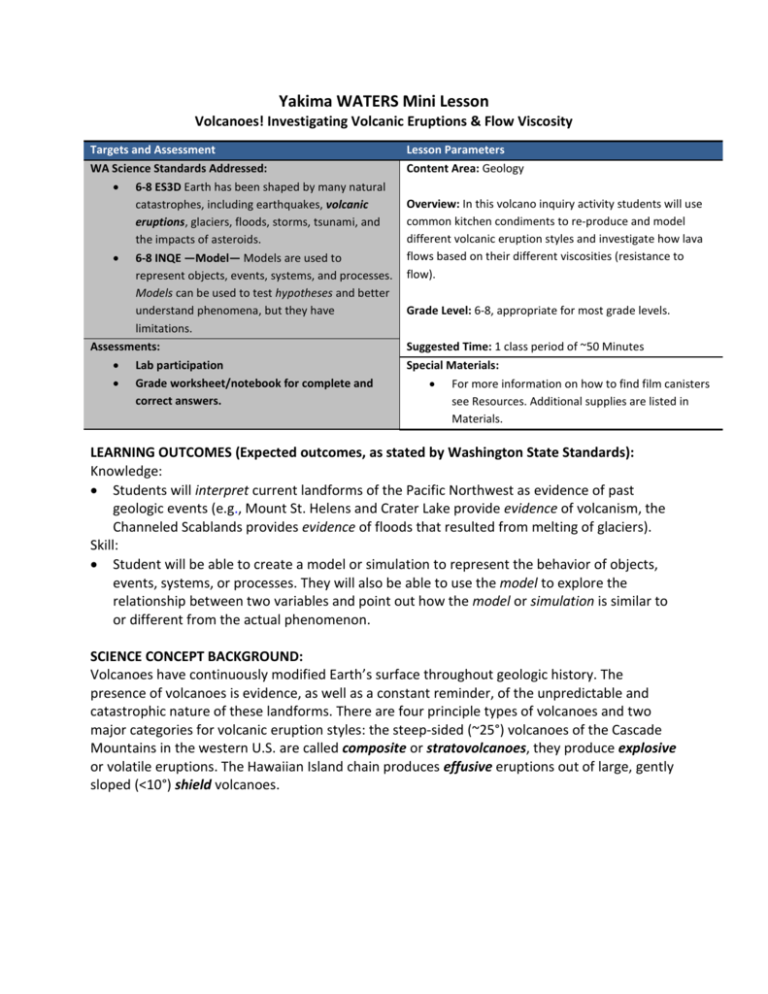
Yakima WATERS Mini Lesson Volcanoes! Investigating Volcanic Eruptions & Flow Viscosity Targets and Assessment WA Science Standards Addressed: 6-8 ES3D Earth has been shaped by many natural catastrophes, including earthquakes, volcanic eruptions, glaciers, floods, storms, tsunami, and the impacts of asteroids. 6-8 INQE —Model— Models are used to represent objects, events, systems, and processes. Models can be used to test hypotheses and better understand phenomena, but they have limitations. Assessments: Lab participation Grade worksheet/notebook for complete and correct answers. Lesson Parameters Content Area: Geology Overview: In this volcano inquiry activity students will use common kitchen condiments to re-produce and model different volcanic eruption styles and investigate how lava flows based on their different viscosities (resistance to flow). Grade Level: 6-8, appropriate for most grade levels. Suggested Time: 1 class period of ~50 Minutes Special Materials: For more information on how to find film canisters see Resources. Additional supplies are listed in Materials. LEARNING OUTCOMES (Expected outcomes, as stated by Washington State Standards): Knowledge: Students will interpret current landforms of the Pacific Northwest as evidence of past geologic events (e.g., Mount St. Helens and Crater Lake provide evidence of volcanism, the Channeled Scablands provides evidence of floods that resulted from melting of glaciers). Skill: Student will be able to create a model or simulation to represent the behavior of objects, events, systems, or processes. They will also be able to use the model to explore the relationship between two variables and point out how the model or simulation is similar to or different from the actual phenomenon. SCIENCE CONCEPT BACKGROUND: Volcanoes have continuously modified Earth’s surface throughout geologic history. The presence of volcanoes is evidence, as well as a constant reminder, of the unpredictable and catastrophic nature of these landforms. There are four principle types of volcanoes and two major categories for volcanic eruption styles: the steep-sided (~25°) volcanoes of the Cascade Mountains in the western U.S. are called composite or stratovolcanoes, they produce explosive or volatile eruptions. The Hawaiian Island chain produces effusive eruptions out of large, gently sloped (<10°) shield volcanoes. Vocabulary Effusive: where lava flows like a thick, sticky liquid up to weeks at a time. In effusive eruptions, degassing is common but ash is usually not. Explosive: where fragmented lava explodes out of a vent over a short and infrequent period of time. In explosive eruptions, the fragmented rock is often accompanied by large amounts of ash and gases that are suspended into the atmosphere. Viscosity: the resistance of a fluid to flow. Fluids with a high viscosity resist flow, the typical response in explosive eruption styles (e.g. Mount St. Helens). Fluids with a low viscosity flow freely, typical in more effusive eruption styles (e.g. Hawaiian or Icelandic shield volcanoes or the Columbia River flood basalts). MATERIALS (1 per student unless stated otherwise): Safety Goggles Aprons (optional) Eruption Styles: Baking soda (~1 tsp per student) Vinegar (1 gallon should be enough for each student to conduct the two eruption styles) Alka-Seltzer tablets (½ tablet per student) Dawn dish soap Film canisters (clear are best for making observations but may be more difficult to find) Dixie cups Flow Viscosity (each student gets ~1 tbsp of each condiment): Ruler Timer Lunch trays or cookie sheets Ketchup Chocolate syrup Honey Vegetable oil Molasses Karo syrup Mustard *Note that these condiments can be substituted with other products and not all of them are needed; the main idea is that the students have several different examples to compare. PROCEDURE: Introduction (~4 min) Begin the lesson with a video, the Mount St. Helens video is great since most students (though they were not alive) are familiar with the volcano and eruption of 1980: Mount St. Helens video (17 sec.): http://www.youtube.com/watch?v=bgRnVhbfIKQ Afterward, have students describe what they saw in the video. Explain that this was an example of an explosive eruption. Then ask… “Are there different types of eruptions? Are all volcanoes the same? Do all volcanoes have explosive eruptions?” Discuss for a moment and from here break into groups and have the students explore… Eruption Styles Set Up (~18 min) 1. Give each student a Dixie cup and film canister. The Dixie cup will be used to produce an effusive eruption and the film canister to produce an explosive eruption. 2. Pour vinegar into the Dixie cup to ~2/3 full. Add a squeeze of Dawn dish soap and mix carefully. Next add 1 tsp of baking soda to the mixture. A reaction should occur immediately. 3. Fill the film canister half way with vinegar. Give each student a half of a Alka-Seltzer pill (or a whole for a more explosive eruption) to put in their film canister. Once they drop the tablet in the student should immediately and firmly put the lid on and step back. It typically takes a few seconds for the pressure to build up before it erupts. The tighter that the seal is on the container the more dramatic the eruption will be. 4. In a notebook or on a worksheet have students record their observations: Lab: Eruptive Styles Date____________ 1. During the first eruption I observed: ________________________________________ ________________________________________________________________________ ________________________________________________________________________ The eruption style is: ______________________________________________________ 2. During the second eruption I observed: ______________________________________ ________________________________________________________________________ ________________________________________________________________________ The eruption style is: ______________________________________________________ 5. Have students share their results with the group. Lava Flow Viscosity Set Up (~18 min) 1. Each student will get a tray, ruler, timer and select at least 4 different condiments. In this activity the condiments will be representing different type of lava flows. Each student will determine whether the condiments have a low or high viscosity. 2. While the tray is lying flat on the table have the students place approximately 1 tablespoon of each product they choose on the tray. Encourage them to be thinking about the viscosities of each item. Below is a figure showing how the set up should look. 3. In a science notebook or handout have each student record the following information: Lab: Lava Flow Viscosity Lab Date____________ 1. Condiments to be tested (list 4): __________________________________________ ______________________________________________________________________ 2. Write a prediction describing how you expect each condiment to move: __________ ______________________________________________________________________ ______________________________________________________________________ ______________________________________________________________________ 3. Record what you observed: _____________________________________________ ______________________________________________________________________ ______________________________________________________________________ ______________________________________________________________________ 4. Now have students tip their trays upward and observe how the lava flows. An extension for this part of the assignment might be to have the students test condiment flow at different angles or to time how long it takes for certain lava types to flow from point A to B, etc. 5. Once they have executed the experiment have them record what actually happened (as seen above in question 3). 6. Have students share their results with the group. Wrap Up (~10 min) 1. Watch the two videos showing the different types of eruptions and lava flows: Mount St. Helens video (17 sec.): http://www.youtube.com/watch?v=bgRnVhbfIKQHawaiian volcanoes video (1.33 min): http://www.youtube.com/watch?v=Hec9yKQQ4o&feature=related After the videos give the students an opportunity as a class to describe; (1) what they observed during the videos and (2) how the video examples compare to the experiments they conducted. 2. Then give the class the vocabulary including the types of volcanoes. I would have them record it in a science notebook if you have the time, if not you can create a handout with all of the new terms. 3. An additional wrap up activity that could be done as a group might be to write effusive and explosive on the board and then have the students write an observation on a post-it note and place it under the appropriate word. As a class you can all look over the answers and have a final discussion about the differences between explosive and effusive eruptions. KEY QUESTIONS: Depending on the amount of time you have left this may end up as homework. To tie the two activities together have students answer the following questions (again this can be completed in a notebook or on a worksheet): 1. What are the two major eruptive styles and the types of volcanoes associated with them? 2. How is the viscosity of lava linked to volcanic eruption styles and the types of volcanoes that they come from? TEACHING TIPS: 1. Depending on how many students and resources you may want them to work in groups of two or alternatively, separate the class into two sections, one for each experiment station. If you decide to create the stations provide approximately 18 minutes per station. 2. If you split the class into two stations, I would also strongly recommend having additional help to both run and set up the activities. It is possible for the activities to run a minute or two shorter, but again organization and help are key to making the experiments run smoothly. 3. The appropriate vocabulary can also be given after each of the experiments while they are still in their groups if time allows, this may also make it easier for the class to answer the given questions. SAFETY WARNING: While the ingredients that are used in this lab are not usually harmful, students should wear protective goggles. Aprons are also good if students are concerned about potentially staining their clothing, mustard is nearly impossible to remove. Students should be warned to not eat any of the lab ingredients. The eruption activity can be very explosive so students should stand back from the film canister quickly after applying the ingredients and placing the lid on. DO NOT STAND OVER OR PUT YOUR FACE OVER THE FILM CANISTER once the lid is on. RESOURCES: Film Canisters can be found for sale in a variety of places including: Local photography printing shops Ebay http://www.sciencebobstore.com/products/Bulk-Film-Canisters-for-Rockets.html Author: Tabitha Trosper, Yakima WATERS Project, CWU, Winter 2011
